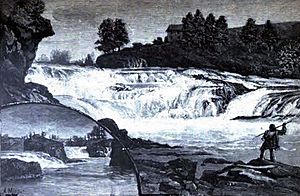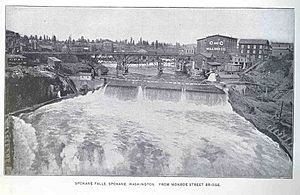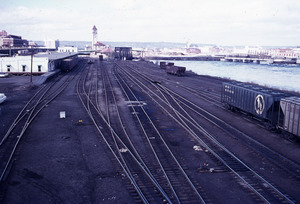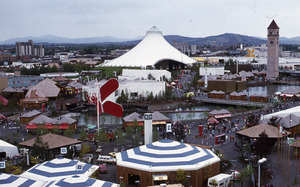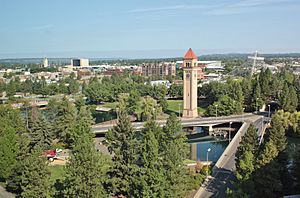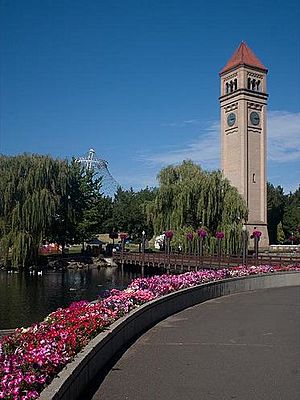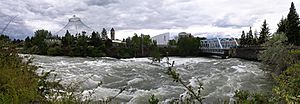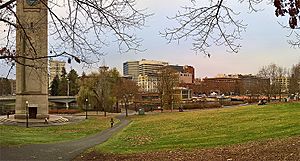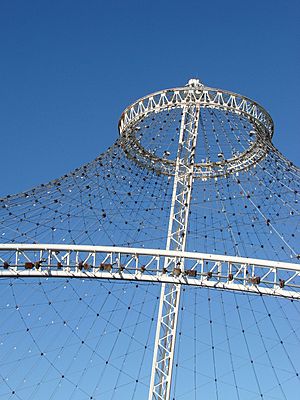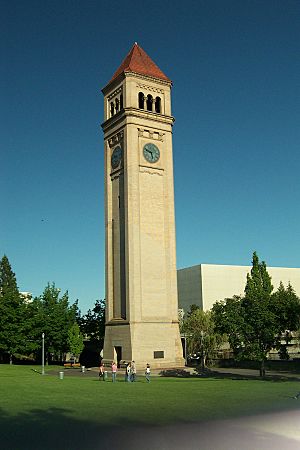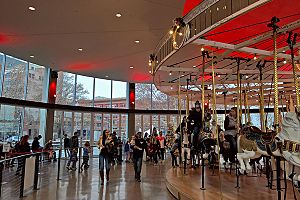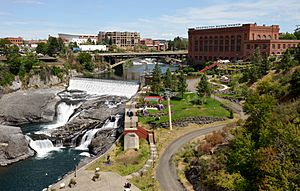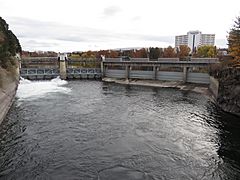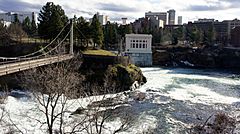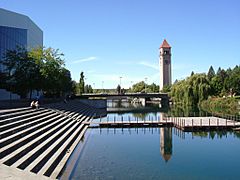Riverfront Park (Spokane, Washington) facts for kids
Quick facts for kids Riverfront Park |
|
|---|---|
 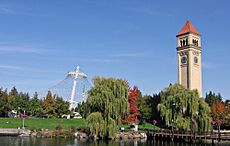
Riverfront Park in 2005
|
|
| Type | Urban park |
| Location | Downtown Spokane, Washington, U.S. |
| Area | 100 acres (0.40 km2) |
| Operated by | Spokane Parks & Recreation Department |
| Status | Open year round (daily, 5 am to midnight) |
| Public transit access | Spokane Transit Authority |
| Website | my.spokanecity.org/ riverfrontspokane |
Riverfront Park, also known as Riverfront Spokane, is a big public park in Downtown Spokane, Washington. The Spokane Parks & Recreation Department owns and runs it. This park is about 100-acre (40 ha) and sits along the Spokane River. It includes the Upper Spokane Falls, which is the second largest urban waterfall in the United States. When combined with the Lower Spokane Falls, it forms the largest urban waterfall in the country.
The park is built on what used to be a busy railyard. People dreamed of turning this area into a park as early as 1908. But it took 64 more years for this dream to come true. In 1972, the old train tracks were removed. The land around the Spokane Falls was cleaned up. This was part of a big city improvement project. The goal was to build a fairground for Expo '74, a World's fair focused on the environment. The fair ran from May 4 to November 3, 1974. After the fair, the plan was to turn the site into an urban park. Riverfront Park officially opened in 1978 after several years of work.
Today, over 3 million people visit the park every year. It has been getting a big makeover since 2016. Some famous buildings, like the U.S. Pavilion and First Interstate Center for the Arts, are still there from Expo '74. The park also has historic attractions like the Looff Carrousel and the Great Northern Clocktower.
Contents
Park History and Evolution
From Railyard to Riverfront Park
Riverfront Park's story is tied to how Spokane first grew. People settled here because the Spokane Falls had strong water power. This power was perfect for mills and businesses in the late 1800s. But over time, many factories and railroads took over the area around the falls. This blocked the view and access to the river.
Native Americans lived near the falls for a long time, using them for fishing. The first American settlers arrived in 1871. In 1873, James N. Glover, a founder of Spokane, bought land and a sawmill here. He knew the river's power was valuable. He also knew the Northern Pacific Railroad Company planned to build tracks nearby.
By the late 1800s, the area was full of sawmills, flour mills, and power plants. Homes on Havermale Island, now part of the park, had to move. This happened when the Great Northern Railway built tracks in 1892. By 1902, trains were running to the city center. Railroads then became a huge part of Downtown Spokane.
In the early 1900s, Spokane became a major rail hub in the western U.S. Four big railroads and several smaller ones came through the city. In 1908, the Olmsted Brothers planned parks for Spokane. They saw how much the railroads had changed the riverfront. They hoped the city would one day reclaim the area for a park.
By 1914, Union Pacific had also built a station and elevated tracks in the park's future location. Downtown Spokane became a busy center for trains for many decades. By the mid-1900s, having so many railroads in the city center caused problems. The elevated tracks and buildings blocked views of the Spokane River and its falls. People even compared it to the Great Wall of China. All the train noise and crossings also caused traffic jams.
Creating the Park: Expo '74 and Beyond
In the 1950s, people started moving out of Downtown Spokane to the suburbs. This made city leaders want to improve downtown. In 1959, a group called Spokane Unlimited formed to help. They hired experts who suggested removing train tracks and making the Spokane River beautiful again.
This plan was big and would take many years. It would also cost a lot of money. Voters did not approve early funding ideas. So, in 1963, Spokane Unlimited hired King Cole to help. Cole started a group called Associations for a Better Community (ABC). This group worked to get community support for a park on Havermale Island.
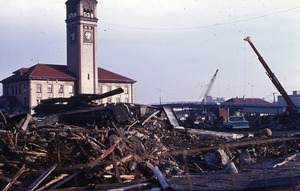
By 1970, the idea of a big event to fund the park grew. A study suggested Spokane host an international exposition. This would bring in money from the state and federal governments. It would also attract tourists. The idea was to host a world's fair in 1974. Spokane would be the smallest city to ever host one.
Getting ready for the fair was a huge challenge. The site had 16 different owners, including the railroads. Money came from local, state, and federal sources. President Richard Nixon officially recognized the event in October 1971. The Bureau of International Expositions also approved it.
The biggest challenge was moving the railroads. King Cole and the Expo '74 planners convinced the railroads to swap land. The train lines were moved south of downtown. This freed up the land for the fair. Demolition began in 1972. Expo '74, focused on the environment, ran from May to November 1974. Nearly 5.6 million people attended.
After the fair, the site was turned into Riverfront Park. President Jimmy Carter officially opened it on May 5, 1978. About 50,000 people came to the ceremony.
Modern Park Upgrades: 2016–2021 Redevelopment
Riverfront Park stayed mostly the same for many years. Its buildings and features started to look old. In 2012, Spokane Park Board decided to make a new plan for the park. They wanted to make it better for future generations. By 2014, a new master plan was ready.
In November 2014, Spokane voters approved a $64.3 million bond. This money would pay for redeveloping Riverfront Park. The bond passed with 67 percent of the votes. This bond did not raise taxes. It replaced an old park tax that was ending. The money from this bond will be used until 2035.
Key projects included fixing up the U.S. Pavilion. They also built a new skate ribbon. This replaced the old Ice Palace. A new building was built for the historic Looff Carrousel. New public spaces, like the Howard Street Promenade, were also created.
Construction started in 2016. A groundbreaking ceremony was held on July 8 at the future Numerica Skate Ribbon. The work continued through 2020 and finished by early 2021. Other city projects nearby, like the Post Street Bridge and Spokane Sportsplex, were also completed.
Park Layout and Connections
Park Geography
Riverfront Park is just north of Downtown Spokane. It is in Spokane's Riverside neighborhood. The park is generally bordered by Spokane Falls Boulevard to the south, Post Street to the west, the northern banks of the Spokane River, and Division Street to the east. Some parts of its North Bank Area go further north.
The Spokane River flows from east to west through the park. It starts as one stream, then splits into three channels. This creates two main islands in the park. The first split creates Havermale Island, the larger island. Further downstream, the northern channel splits again. This creates snxw meneɂ (formerly Canada Island). These northern two channels hold the Upper Spokane Falls. All three channels join back together downstream of the Upper Falls.
Park Areas
Riverfront Park has a few main areas. These include the South Channel area, Havermale Island, and the North Bank area. The South Channel area is along the southern part of the Spokane River. It has features like the Looff Carrousel, Numerica Skate Ribbon, and Rotary Fountain. This area is also the main entrance to the park from the south.
North of the South Channel is Havermale Island. This island has grassy areas, nature spots, and outdoor theaters. It also has the U.S. Pavilion and the Great Northern Clock Tower. The northern part of the park is called the North Bank area. It is across the Spokane Falls from Havermale Island. Before the recent makeover, this area was mostly for parking and park maintenance. Now, much of the North Bank area is being built into a fun playground and Sportsplex.
Connecting with the City
Riverfront Park is right in the middle of Downtown Spokane. This means it's a city park. The southern edge of the park, along Spokane Falls Boulevard, acts like a "streetwall." This is similar to other city parks like Central Park in New York City. There have been talks about building heights along this edge. Some worry that tall buildings would cast shadows on the park.
The park is well connected to the areas around it. The southern and western borders have sidewalks that lead right into the park. The First Interstate Center for the Arts and Spokane Convention Center are also connected to the park. They have walkways and terraces that make it easy to go between the buildings and the park. Access along the northern riverbank is a bit harder due to the natural landscape and private buildings. But there are still trails that connect to roads and parking lots.
Many paths and roads go through the park, connecting it to wider areas. The Spokane River Centennial Trail enters the park from the east. It winds through the park, passing many attractions. These include the Spokane Convention Center, First Interstate Center for the Arts, Red Wagon, Looff Carrousel, Rotary Fountain, and the Numerica SkyRide and Skate Ribbon. The trail leaves the park on the west side, continuing towards Kendall Yards and Riverside State Park.
The Howard Street Promenade connects Downtown Spokane to the North Bank areas. It runs from the Rotary Fountain, across snxw meneɂ, to the park's northern entrance. This makes it easy to walk straight through the park from north to south. Other paths, like pedestrian bridges over the Upper Spokane Falls, also connect different parts of the park. The Washington Street Bridge carries cars and people through the park's center.
Park Features and Fun Attractions
Natural Wonders and Green Spaces
The Spokane River and Spokane Falls are the park's main natural attractions. You can see them from many places in the park. Along the calm south channel of the river, paths and lawns go right up to the water. Visitors can get close to the river and even fish there sometimes. The north channel, where the falls are, has faster water. It's harder to get close there. But there are special viewing spots, like two pedestrian suspension bridges. These bridges offer amazing close-up views of the falls.
Some walkways, like in the old YMCA area, run right next to the falls. Riverfront Park also has many open grassy areas. These are on the south side of Havermale Island, facing the calm river channel. They include the Lilac Bowl, which is a natural outdoor theater, and the Clock Tower Meadow.
Buildings and Built Attractions
Riverfront Park is also famous for its man-made attractions. Two of its structures, the U.S. Pavilion and Great Northern Clocktower, are well-known Spokane landmarks. They have been on the park's logo for years. The latest park logo, from 2017, shows abstract shapes of these landmarks. The logo uses the triangle shape of the pavilion and the thin rectangle of the clocktower. It also includes shapes inspired by the pavilion's cables and Spokane's street layout.
U.S. Pavilion
The U.S. Pavilion is a steel and cable structure in the middle of Riverfront Park. It's on Havermale Island. This Pavilion was built for Expo '74 and was the United States' main building. Today, it's used for events, with both indoor and outdoor spaces. It has an amphitheater, walkways, and viewing platforms. When no events are happening, it's an open public space with views of the Spokane River.
Pavilion History
The U.S. government decided to join Expo '74 because of its environmental theme. They wanted to show the world what the U.S. was doing for the environment. They also hoped it would bring more tourists and trade. It was decided that the U.S. would build a permanent pavilion. This way, it could be used by the city after the fair. The City of Spokane gave four acres of land for the Pavilion.
Many design firms competed to create the Pavilion. Naramore, Bain, Brady & Johanson (now NBBJ) won the final design contract. The Pavilion was designed to look like a giant tent. This fit the fair's environmental theme. It was the largest building at the fair. In 1972, the U.S. Congress gave $11.5 million to build it. Construction started on May 1, 1973. The Pavilion's tower is 150 feet tall. Its structure uses about 4.6 miles of cables.
The Pavilion originally had a vinyl cover, which was removed in 1979. Since then, it has had its famous skeleton look with exposed cables.
Pavilion Renovation
The Pavilion was fully renovated as part of the park's recent makeover. The old IMAX theater and other structures were removed. The new Pavilion opened on September 6, 2019. It has an open space for events and sloped seating areas. One indoor space remains for tickets, rentals, and park offices. A 40-foot platform was built in the center for river views.
The new design added plexiglass "blades" with LED lights to the cables. There are 476 blades that light up at night. They create animated light shows on Fridays, Saturdays, and Sundays. Special shows are made for holidays and events. In 2020, the Pavilion's lighting design won awards.
Great Northern Railway Clocktower
The Great Northern Railway Clocktower is on Havermale Island. It was built in 1902 as part of the Great Northern Railway Depot. When the park was built for Expo '74, the depot was torn down. But people wanted to save the clock tower, so it stayed. It is now a Spokane icon. It reminds people how important railroads were to Spokane's growth.
You can see where the old depot's roofline was. The brick color changes on the tower's face. The tower is 155 feet and 6 inches tall. It has nine-foot wide clock faces on all four sides. A 700-pound brass pendulum controls the clock. Park staff must hand-crank it every week. The clock chimes every hour, but it has never had real bells. It has always used electronic speakers to make chime sounds.
Looff Carrousel
Riverfront Park has a famous carousel built by Charles I. D. Looff. He built the first carousel at Coney Island. Spokane's carousel was built in 1909 as a wedding gift for his daughter. It was first at Natatorium Park until 1968. Expo '74 organizers wanted to show it, but it was too expensive to move and fix. In 1975, it was finally installed in Riverfront Park. It was housed in the building that was the German Hofbrau during the fair.
The carousel closed in 2016 for the park's redevelopment. It was stored and fixed up. The old building was torn down, and a new one was built. The new carousel building opened on May 12, 2018.
Numerica SkyRide
The Numerica SkyRide is a gondola lift ride. It's at the southeast corner of Riverfront Park. The ride takes people over Huntington Park and down into the Spokane River gorge. You can see the Lower Spokane Falls from above. The ride crosses the river and loops back to the park.
The current SkyRide was built in 2005. The original ride was from the 1960s and bought for Expo '74. It had two routes then. One went over the fairgrounds, and one went over the falls. The fairgrounds route was removed after Expo. The Falls route stayed. The old ride had open gondolas. The 2005 project rebuilt the ride with enclosed gondolas.
Numerica Credit Union bought the naming rights for the SkyRide in 2019. This deal also included the Numerica Skate Ribbon.
Numerica Skate Ribbon
The Numerica Skate Ribbon opened in 2017 as part of the park's redevelopment. It's at the southwest corner of the park. This ribbon is for skating all year round. You can roller skate in warm months and ice skate in winter. It also has a cafe and hosts events like art walks and weddings.
The ribbon replaced the old Ice Palace. That rink was set up under the U.S. Pavilion each winter. The new ribbon has a winding, sloped path that is 715 feet long. It also has an ice pond. Some people didn't like the new design. They said it wasn't good for hockey or large skating classes.
In February 2019, Numerica Credit Union bought the naming rights for the Skate Ribbon and SkyRide. This deal brings in $90,000 a year. This money helps pay for park programs and upkeep.
Red Wagon
The Red Wagon, officially called The Childhood Express, is a giant play sculpture. It looks like a Radio Flyer wagon. The Junior League and local businesses paid for it. It was given to Spokane's children on August 18, 1990. This was for Washington State's 100th birthday.
Local artist Ken Spiering sculpted it. The wagon is 12 feet (3.7 m) high and 27 feet (8.2 m) long. It weighs 26 tons and is made of steel and concrete. You can go inside the wagon using a staircase at the back. There's a wooden platform inside where you can walk around. The wagon's handle is a playground slide for exiting.
The Red Wagon is along Spokane Falls Boulevard. It's between the First Interstate Center for the Arts and the Looff Carousel.
Art in the Park

Riverfront Park has many art installations. About half of Downtown Spokane's sculptures are in the park. The art comes from different artists and styles. Some are abstract, some are lifelike, and some are whimsical. They serve different purposes. Some are memorials, like for the Vietnam War or astronaut Michael P. Anderson. Others honor local Native American heritage. There are also interactive play sculptures.
Local artist Harold Balazs created several pieces in the park. His most famous are the Centennial Sculpture, which floats in the Spokane River, and the Rotary Fountain.
Garbage Goat
One of the park's most popular art pieces is Goat. It was installed in 1974 for Expo '74. People usually call it the "Garbage Goat" or "Garbage Eating Goat." It's located east of the Looff Carrousel. The sculpture was made to fit Expo '74's environmental theme. It's an interactive art piece that also collects trash.
The Spokane Women's Council of Realtors sponsored its creation. Sister Paula Mary Turnbull, a local nun, sculpted it. The sculpture looks like a goat and has a vacuum inside its mouth. You can "feed" it small pieces of garbage.
Before it was even installed, the art piece caused a debate. Dairy goat farmers protested. They said the sculpture made people think goats eat anything. They wanted the public to know that goats need proper food. A deal was made. The garbage goat was installed. In return, real dairy goats at the fair got signs. These signs explained that goats produce milk if fed healthy food.
Over the years, the goat has become very popular. It has an unofficial Facebook page with thousands of followers. The Spokane County Solid Waste System even named its public education blog after it. For its 40th birthday, the City of Spokane held a celebration. They "fed" the goat birthday cake. There was also a goat-themed party for the public.
Future Park Features
A new playground is being built on the park's south end. It's near the Upper Falls Power Plant. This playground is designed by Shane's Inspiration. It will be open in the fall of 2020. This project is funded by donations, not the park's redevelopment bond. Providence Health & Services gave $1 million. Shane's Inspiration designs playgrounds that are inclusive. This means they are accessible for all children, including those with disabilities. Spokane's will be the first of its kind. The playground will be about 13,000 to 14,000 square feet. About 5,800 square feet will be a sensory playground.
Former Park Features
Before its recent makeover, Riverfront Park had these features:
- The Ice Palace was a seasonal ice skating rink. It was set up under the U.S. Pavilion. It opened in 1977 and closed in 2017. The permanent Numerica Skating Ribbon replaced it.
- The IMAX Theater was part of the U.S. Pavilion. It opened in 1978. It was very popular until 2005. But then another IMAX opened nearby. The park's IMAX also lost its license to show big Hollywood movies. So, it closed in 2016 and was torn down in 2018.
- The Pavilion Rides were amusement rides owned by the City of Spokane. They were set up under the U.S. Pavilion each summer. These rides didn't fit the new vision for the Pavilion. The park board decided to remove them in 2018. Some of the rides were sold off.
Hydropower and the Spokane River
Early Power History
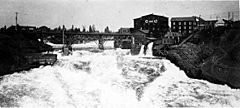
The fast-moving Spokane River and Spokane Falls have been used for power for a long time. Since the 1870s, people used waterwheels to power sawmills and flour mills. On September 2, 1885, hydroelectricity first powered Spokane. George A. Fitch installed a generator in the C & C Flour Mill. It lit up 10 to 11 lights in downtown.
As more electricity was needed, new power companies formed. In 1886, the Spokane Falls Electric Light and Power Company bought Fitch's business. They bought 1,200 light bulbs from Thomas Edison's company. They also bought a 30-kW plant from Edison. This plant powered the city's first opera. The company later became the Edison Electric Illuminating Co. of Spokane Falls (EEICSF).
By the late 1880s, Spokane needed a lot more electricity. This led to two new power companies: Spokane Falls Water Power Co. and Washington Water Power (now Avista Utilities). Washington Water Power started building a generator on the Lower Spokane Falls. Then, Spokane's Great Fire happened in 1889. After the city rebuilt, even more electricity was needed. Washington Water Power built a bigger power plant on the Lower Falls. This included an 18-foot tall dam. The new plant was called the Monroe Street Power Station. It was finished on November 12, 1890. This huge plant helped Washington Water Power become the main power company. They bought out other companies. By 1892, the Monroe Street Power Station could generate 1,439 kilowatts.
Modern Hydropower
In 1922, Washington Water Power built another dam. It's called the Upper Falls Diversion Dam. It's at the eastern tip of Havermale Island. This dam sends water through the Spokane River's South Channel. This water feeds a 10 MW generator at the Upper Falls Power Plant, also built in 1922.
The old Monroe Street Dam was damaged. It was replaced with a concrete dam before Expo '74. This new dam also included Huntington Park. This park lets visitors see water flowing into the power plant. In 1992, the Monroe Street Power Station got a new underground powerhouse. Its old 1890 generator was given to the Henry Ford Museum. A new 15-MW generator was installed.
Hydropower's Legacy in the Park
The history of using the Spokane Falls for power is still visible in Riverfront Park today. Huntington Park, the Lower Spokane Falls, and the Monroe Street Power Station are key sights on the Numerica SkyRide. In 2014, Huntington Park was renovated. It added a new plaza that connects to Spokane City Hall. This makes it feel like an extension of Riverfront Park.
The Upper Falls Diversion Dam also shaped the park. It created the calm waters of the South Channel. This area is home to many park attractions. These include the Looff Carousel, Red Wagon, and First Interstate Center for the Arts. The calm water lets visitors get close to the river. They can interact with it from steps and viewing platforms.
Festivals and Events
Every year, Riverfront Park hosts many popular Spokane events:
- The annual Lilac Bloomsday Run is held in May. Riverfront Park is where post-race activities take place.
- Spokane Hoopfest happens every June. Riverfront Park is used for exhibitors, vendors, and its Nike Center Court.
- The 4th of July features an annual carnival and fireworks display.
- The Royal Fireworks Concert is an annual concert. It ends with Handel's Music for Royal Fireworks and fireworks.
- Gathering at the Falls Powwow is an annual summer celebration. It honors the living culture of native people.
- Pig Out in the Park is a food and music festival. It's hosted in the park during Labor Day weekend.
Images for kids
-
Spokane Falls, 1880.


